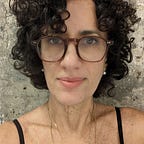Displaced: the long road to safety
Exploring the limits of what we can do with classroom-ready creative tools.
Click here for Displaced, an interactive story.
The story
For our LEAP 3 project, the task was to tell a personal story and reflect on the complicated business of being human. At around the time we started thinking about this assignment, a young Congolese immigrant named Moïse Kabagambe was brutally murdered in Rio de Janeiro; that horrible crime shook the country, and led me to consider the very different ending afforded to my father, himself a WWII refugee and an immigrant in Brazil, as well as my own experiences as an expat. Evidently, otherness can be experienced in many different ways, not only according to historical circumstances, but also because of ethnicity and socio-economic status. And just as I started researching this topic, Russia invaded the Ukraine — reigniting a violent conflict in the very region that my family had fled from, and again touching me in a very personal way. Two million people were left displaced in the first two weeks of the conflict — the largest ever human movement in such a short period.
The topic of human migrations has been on my mind for a while. In 2015, at the height of the refugee crisis in the Mediterranean, I went to Rome to take part in a two-week mediathon, centered on finding ways in which media and storytelling could have a positive impact on the crisis. I decided to craft a story around this universal and at the same time very personal issue; I wanted to try to weave together all these characters — my father’s family, Moïse, the Ukranian refugees, all united in the very human quest for freedom and safety. Having found the angle of displacement, the problem then became how to structure the story — finding a narrative device that would hold it all together.
The design
“Ask a story how it wants to be told”, I always tell my students; and so I did. Human migration is a complex and multifaceted issue; perhaps the key would be to highlight just that. It was then that I realised that the Jewish Passover holiday would soon be upon us. I am not a religious person, far from it — but this holiday which is dedicated to celebrating a people’s exodus, a flight from oppression, the right to freedom and safety, and the values of solidarity and empathy, has always been my favorite. And this year, it seems more relevant than ever.
The passover ritual, or Seder, includes setting a plate with different food items representing different parts of the narrative. The a-ha moment came when, inspired by a site menu in the “Who is Daiani Cristal” documentary web site, I decided to use the seder plate as an index, the design encouraging exploration and non-linear reading. Conceptually, the circular shape tells us that this is a never-ending story. And, like the symbols of the Passover ritual, the different elements remind us of the history and ramifications of human migrations, help us build the bigger picture, and also lead us to consider our own place in the story.
The tools
Because I wanted the narrative to be non-linear, a video was out of the question; an interactive presentation would be ideal. Genially is one of the creative tools marketed to educators, with a relatively easy learning curve but some powerful features, which include some interactive design possibilities. I haven’t used it much, so, as a bonus, I would also learn something new. I decided to put it to the test, and added a constraint: I had to create all assets within the app. Even though I might get better results by going outside of Genially to create video and audio, this constraint would allow me to assess if a moderately tech-savvy person could use this tool to create a complete multimedia piece with satisfactory results.
The only other tool I used was Workflowy, a note-taking and writing application. The nesting feature is great for visualizing the overall story structure, and working on different parts independently. I really like how it supports the generative nature of the creative process, first for capturing research and random insights, then allowing me to connect and flesh out ideas, and finally helping me easily move things around for a better narrative flow. It’s a really wonderful tool to support the preparation / incubation / illumination model of creativity, as defined by Graham Wallas.
Conclusion
I am hoping this project demonstrates how we can do a deep dive into a subject and explore it from different angles, opening up further questions. I also aim to illustrate how a story’s elements, and your own narrative intentions, should shape the final form. Finally, I hope to encourage students and educators to embark on creative exploration of narrative forms. With so much media available for us to research and remix, and creative tools becoming so accessible, it’s easier than ever to produce polished work, with well-constructed ideas and plenty of attention given to detail in the final product.
This work was produced as an assignment for the Digital Authorship seminar, part of the Graduate Certificate in Digital Literacy at the University of Rhode Island, in which we explore digital and media literacy through focusing on the critical and creative practices of self-expression, advocacy, and the advancement of learning communities.
